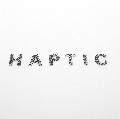Today I visited the Haptic exhibition at The Lighthouse, Glasgow's museum for design and architecture. This is a touring exhibition for which Japanese designer Kenya Hara, Chief Executive of the Nippon Design Centre and MUJI, commisioned 21 international architects and designers to "create objects that focus on the sense of touch, instead of colour and form".
The result is a beautifully varied and engaging exhibition, each piece presented lucidly with a short synopsis and material sample so that the audience can appreciate the tactility of the objects. I highly recommend popping along if you're in Scotland.

A couple of pieces address customisation through tactility: Reiko Sudo's Gazelles table uses textile inspired by animal fur as a tool for users to adapt the table - a collaboration itself with product designer Ricca Tezuchi; each of Keiko Hirano's Paper Wastebaskets is completely unique, being formed by crumpling a paper sachet when wet, a material which dries to form a harder 'can', a strangely resilient feeling paper object. It is worth noting themes of paper, hair, and jelly like materials in this exhibition! Notable exceptions and thus my favourites were Juice Skin by Naoto Fukasawa, packaging that feels like fruit, and Shishiodoshi by Kenya Hara, a kind of ethereal perpetual water installation from defiantly dry paper (there's that stuff again!).
The Hara Design Institute Nippon Design Centre website has a comprehensive collection of images that illustrate what I'm on about!
This all got me thinking about the inherent lack of tactility in digital fabrication, or should I say 'slow' tactility: we can design products entirely on paper and CAD and have no idea how they will feel until the prototype or finished product is made. This is surely greatly inferior to a process where one is designing through touch, with the material in hand from the beginning. That might not be the case when our fabricators are very local, but until then we are seriously impaired by this gap between concept and fruition. I think this is why papercraft holds such interest for me - its immediacy and accessibility with current tools makes it so much more fathomable than, say, 3D printing.
I long for the day when we can have the best of both worlds: a completely haptic and digital system for design and fabrication, whether through enhanced simulation, or preferably through immediate and cheap fabrication.



1 comment:
Post a Comment